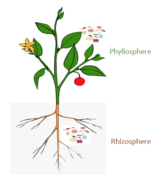| Part of a series on |
| Microbiomes |
|---|
 |
Virome refers to the assemblage of viruses[1][2] that is often investigated and described by metagenomic sequencing of viral nucleic acids[3] that are found associated with a particular ecosystem, organism or holobiont. The word is frequently used to describe environmental viral shotgun metagenomes. Viruses, including bacteriophages, are found in all environments, and studies of the virome have provided insights into nutrient cycling,[4][5] development of immunity,[6] and a major source of genes through lysogenic conversion.[7] Also, the human virome has been characterized in nine organs (colon, liver, lung, heart, brain, kidney, skin, blood, hair) of 31 Finnish individuals using qPCR and NGS methodologies.[8]
- ^ Anderson NG, Gerin JL, Anderson NL (July 2003). "Global screening for human viral pathogens". Emerging Infectious Diseases. 9 (7): 768–774. doi:10.3201/eid0907.030004. PMC 3023425. PMID 12890315.
- ^ Zárate S, Taboada B, Yocupicio-Monroy M, Arias CF (November 2017). "Human Virome". Archives of Medical Research. 48 (8): 701–716. doi:10.1016/j.arcmed.2018.01.005. PMID 29398104.
- ^ McDaniel L, Breitbart M, Mobberley J, Long A, Haynes M, Rohwer F, Paul JH (September 2008). "Metagenomic analysis of lysogeny in Tampa Bay: implications for prophage gene expression". PLOS ONE. 3 (9): e3263. Bibcode:2008PLoSO...3.3263M. doi:10.1371/journal.pone.0003263. PMC 2533394. PMID 18810270.
- ^ Wilhelm SW, Suttle CA (1999). "Viruses and Nutrient Cycles in the Sea". BioScience. 49 (10): 781–788. doi:10.2307/1313569. ISSN 1525-3244. JSTOR 1313569.
- ^ Wegley L, Edwards R, Rodriguez-Brito B, Liu H, Rohwer F (November 2007). "Metagenomic analysis of the microbial community associated with the coral Porites astreoides". Environmental Microbiology. 9 (11): 2707–2719. Bibcode:2007EnvMi...9.2707W. doi:10.1111/j.1462-2920.2007.01383.x. PMID 17922755.
- ^ Barr JJ, Auro R, Furlan M, Whiteson KL, Erb ML, Pogliano J, et al. (June 2013). "Bacteriophage adhering to mucus provide a non-host-derived immunity". Proceedings of the National Academy of Sciences of the United States of America. 110 (26): 10771–10776. Bibcode:2013PNAS..11010771B. doi:10.1073/pnas.1305923110. PMC 3696810. PMID 23690590.
- ^ Sharon I, Battchikova N, Aro EM, Giglione C, Meinnel T, Glaser F, et al. (July 2011). "Comparative metagenomics of microbial traits within oceanic viral communities". The ISME Journal. 5 (7): 1178–1190. Bibcode:2011ISMEJ...5.1178S. doi:10.1038/ismej.2011.2. PMC 3146289. PMID 21307954.
- ^ Pyöriä L, Pratas D, Toppinen M, Hedman K, Sajantila A, Perdomo MF (2023). "Unmasking the tissue-resident eukaryotic DNA virome in humans". Nucleic Acids Research. 51 (7): 3223–3239. doi:10.1093/nar/gkad199. PMC 10123123. PMID 36951096.